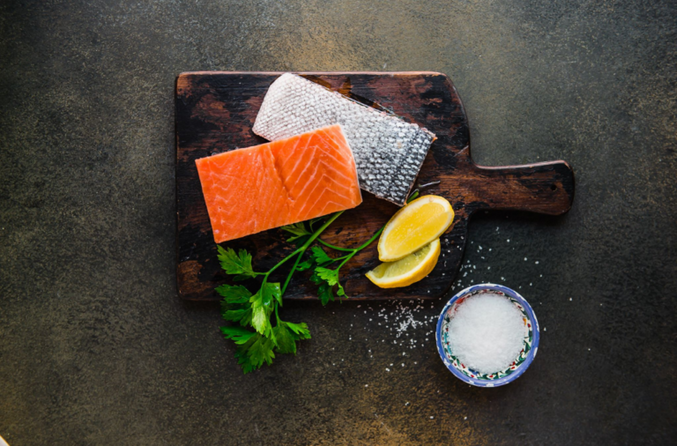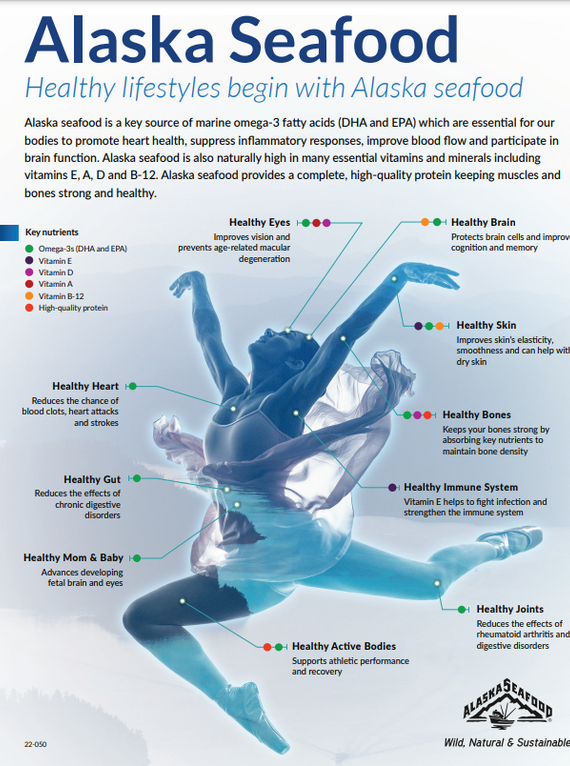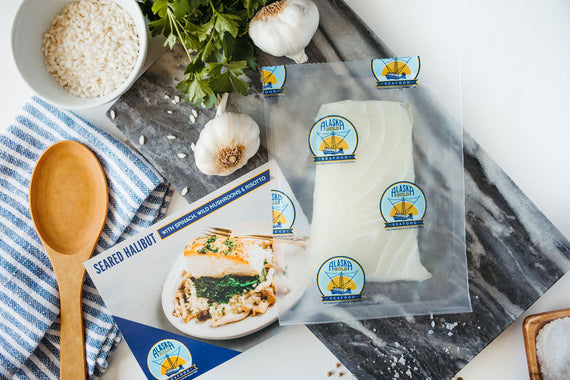
The easiest way to cook our fish is simply. All of us in the office and just about all of the fishermen in our fishermen-owned co-op keep it real simple by rubbing the fish lightly with a little olive oil and sprinkling with sea salt and a little freshly ground pepper. When working with premium-quality seafood, use minimal seasonings and let the fish’s natural flavors stand out. Some will add garlic or some other herb, or a simple flavored salt. There is no need to do anything more than that to enjoy our Alaska Gold Seafood.
What is different about cooking fish versus other meats is that fish cooks faster. All fish can dry out quickly and its delicious moist flavor is lost if too dry. Remember: Fish continues to cook after removed from the heat source. In cooking you seafood, you want to aim for medium-rare to medium (between 125° F and 140° F if you have an instant-read thermometer) and avoid overcooking. Good rule of thumb is the 8-minute rule, which says you should measure the fish at its thickest point, and cook it for 8 minutes per inch, turning halfway through the cooking time. The fish should be cooked until it is almost opaque throughout but still moist.
Below we offer a few tips on several seafood cooking methods to help you get started.
Remember to keep it simple with your Alaska Gold seafood. With some salt and a bit of lemon, our Alaska Gold king salmon makes a delicious dinner.
Seafood preparation/Thawing tips: When you’re ready to cook, take the number of vacuum-sealed portions you’d like to eat out of the freezer. You can use one at a time, or more as needed. These vacuum-sealed packs are very convenient for one person or cooking for the whole family. Thaw under refrigeration for 24 hours. We recommend breaking the vacuum seal before thawing. Before mealtime, take the portion(s) out of the fridge and let sit at room temperature for 10-15 minutes. Use scissors to take the fish portion(s) out of the vacuum-sealed pack(s). Wipe the fish down with a paper towel.
In a pinch, you can thaw your portions by running them under cold water. You will lose a bit of quality, as you ideally want the fish to thaw as slow as possible, which is why we recommend thawing under refrigeration. It is best to use the thawed fish within 24 hours after it thaws.
Sashimi: We recommend NOT cooking our sashimi-grade albacore tuna and serving the tuna raw as sashimi or poke. You can also sear on each side for 2 minutes or less, but the albacore is outstanding as sashimi. When serving sashimi, cut to desired thickness while still partially frozen.

Seafood Grilling Tips: Heat up and oil the grill. Just as it is with any other meat, you can prevent sticking by making sure that the fish is dried with a paper towel, lightly oiled, and perhaps most importantly, ensuring the grill is as hot as possible. Once the fish is on the grill, turn the grill down to medium heat (~300-350° F). Another note if you have trouble overcooking with your grill is that grill marks look great in pictures, but one way to prevent your fish from drying out is to wrap it in tin foil or some other heat-resistant covering. Some call this “making a tent” for the fish. The French call this method “en papillote,” but we call it “making a tent.” This can be done when baking in an oven, too. But in an oven you can use parchment paper, whereas in a grill there can be a fire danger with hot coals or any flame. Another way is to use a cedar or alder plank. See this cedar plank salmon recipe. Cook until just opaque throughout.

Seafood Baking Tips: Baking seafood is really easy! Our salmon portions (king salmon, coho salmon, and keta salmon portions) can conveniently be cooked for 8 minutes at 425 F with your favorite seasons for a super easy weeknight meal. Place seasoned fish in baking dish and cook for 8 to 10 minutes depending on thickness of fillet or portion and/or quantity of portions used. We’ve found that cooking our sablefish works best at higher temperatures. Bake at 450° F for 9-10 minutes. It is difficult to overcook sablefish, because it is so loaded with omega-3 fatty acids. Remove fish when it begins to flake easily.
Slow Oven Roasting Seafood Tips: Some find that slow roasting salmon is a foolproof method to prevent dryness. It makes sense to slow roast larger pieces like our coho salmon fillets (sides). Preheat oven to 250° F. Place seasoned fish in roasting dish on center rack for 20 minutes. Look for it to be opaque throughout. And then pull the fillet from the oven. The nice thing about slow roasting is that slow roasting is more forgiving and won’t cook as much after removing.
Poaching Seafood Tips: Poaching salmon, particularly our coho salmon portions or keta salmon portions, is a popular option. In a large, deep, straight-sided skillet or heavy pot, heat enough water to just cover the salmon. You can also use broth or a combination of vegetables like carrots, celery, onion, lemon, a splash of white wine, and several pinches of salt (there are many other options for flavoring). Bring the water or broth combination to a boil. Add salmon portions seasoned with salt and gently lower into pot. Reduce to a simmer, cover, and cook 5-8 minutes. *The key is to cook the salmon just under boiling, a very slow simmer. The salmon is done when opaque throughout. Use spatula to remove.

Pan-searing and Sautéeing Seafood Tips: Pan-searing salmon is easy and quick. Heat a cast-iron skillet or non-stick pan. Here’s how to pan-fry and sauté without the sticky mess and oil spatters. Dry your fish as much as possible with a paper towel. Use just enough oil to cover the bottom of the pan. The easiest way to avoid sticking is to make sure the fish is at room temperature. After thawing, let the fish sit on your kitchen counter for 20 minutes or so. Cook at a medium-high heat and make sure the pan is HOT before you add fish (way too hot to touch). Time: use the 8-minute rule! For every inch cook for 8 minutes flipping half way through. Remove immediately. You will know that you are searing right if you see the beginnings of a light brown crust. See our pan-seared halibut recipe.
Seafood Leftovers: We hope that you don’t have leftovers, but if you get our larger coho salmon fillets, you might have enough for a second meal. Seafood, especially salmon, does not benefit from being reheated. If not reheated very carefully, fish can get a rancid flavor. Not to worry, that being said, we love making salads with leftover salmon. Another option is to throw leftover salmon onto eggs once the eggs have cooked for a little while. This will make a delicious, nutritious protein-packed breakfast!
Also, check out these recipes and seafood preparation tips from our customers.



